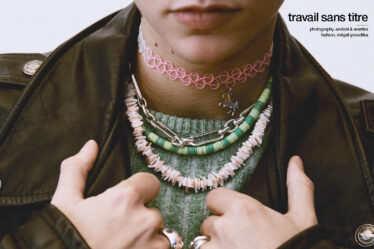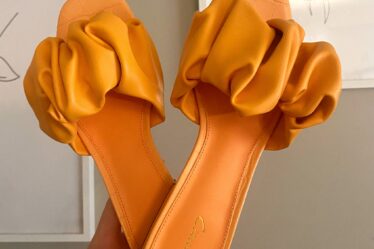
In a single season, Major League Soccer — North America’s top football competition — goes through 13,000 pairs of cleats and 5,000 balls. These products, along with thousands more jerseys, shorts and socks worn by players throughout a 34-game schedule, will largely end up in the bin after eight months in use.
That’s at least according to Gabriella Mas, the founder behind a new line of apparel called (Re)boot, made from upcycled sports gear. For her first collection, Mas convinced Inter Miami CF, the Major League Soccer team part-owned by David Beckham, to be her supplier.
After just a few trips to Inter Miami CF’s facilities, Mas — whose father Jorge Mas is the managing owner of the team — collected hundreds of used jerseys and deflated footballs, 400 pairs of football shoes and other equipment. The discarded jerseys were then used to create a collection of upcycled jerseys and shorts for the club’s affiliated youth teams in March. Mas plans to use the other materials to create an outfit for Inter Miami CF’s first ever mascot in the 2024 season.
But the jerseys and equipment Mas collected barely made a dent in the team’s heaps of apparel and equipment gathering dust in a warehouse.
The professional sports industry is a substantial contributor to fashion’s waste crisis, with millions of items being used as little as twice per game. Major sportswear brands like Nike, Adidas and Puma — which manufacture performance wear for sports teams around the world — produce hundreds of thousands of units per season to meet the industry’s needs. It’s customary, for example, for some professional football teams to provide three new jerseys per player, per match. In the Premier League, this would mean that for the 11 starting players, 1,254 jerseys are required for the 38-game season alone.
On top of this, there is a plethora of other gear including training kits — garments like tracksuits, tops and shorts that players wear to practice and warm up in — and travel wear. Amplified across the entire professional sports industry, this amounts to mountains of obsolete apparel and equipment, much of which eventually finds its way into landfills, according to Mas.
No official data exists on the amount of apparel produced for teams and athletes each season, or how much of it ends up in a landfill.
“This isn’t a problem only with football, it’s a problem baked into the entire DNA of the sports industry,” Mas said.
The materials traditionally used to make performance sportswear are also part of the issue. Most football jerseys, for example, are made from 100 percent recycled polyester for its ultra-lightweight and sweat-wicking qualities. The problem is that almost all of the recycled polyester available on the market today comes from plastic bottles, not old clothes, meaning that plastic is much harder to keep in circulation — for example, for use in future products — than if it had remained a bottle that could be recycled again and again.
Beyond producing performance gear for professional teams, the likes of Nike, Adidas and Puma churn out millions of units of replica merch and fan jerseys every year, and leftover seasonal merchandise that can’t be shifted to off price retailers must be liquidated or destroyed.
But one sport’s trash can become a designer’s treasure. A small but growing number of resourceful brands are now seeking secondhand sports gear to produce upcycled collections. It helps that a sporty aesthetic — often lumped into TikTok-favourite “#blokecore” trend characterised by outfits that include vintage football shirts, jeans and terrace sneakers like Sambas or Gazelles — is trending among fashion consumers. Kim Kardashian became an unlikely blokecore proponent when she attended a basketball game in February wearing the jersey of the historic Italian football club AS Roma paired with bike shorts and sleek black sneakers.
London-based Brazilian designer Renata Brenha saw her sales swell when she first introduced football-inspired pieces such as a £385 ($494) pleated jersey skirt made from a patchwork of old jerseys in her collection this year. What began as an experiment has become a staple of the brand, and Brenha’s upcycled sportswear pieces have garnered her business with wholesalers including Matchesfashion.
Limited Solutions
While Mas is in discussion with several other Major League Soccer teams about similar partnerships and has ambitions to one day work with sports teams in Europe, (Re)boot is one of only a handful of small companies dedicated to addressing the issue of sustainability in sports. Upcycling projects are also notoriously hard to scale because of the cost and inconsistency in sourcing the materials, as well as the labour intensive process of creating individual garments.
“Upcycling is obviously hard to scale because it’s a big, big kind of draw on the designer,” Mas said. “It’s all manual, fully handcrafted and each garment is unique.”
The only actions likely to shift the needle in the short term must come from the sportswear companies that produce the apparel in such vast quantities, she added. While all have acknowledged the need for a new approach to sportswear manufacturing, efforts so far have been sporadic.
Nike, Adidas and Puma all offer fan jerseys for sale made from recycled polyester, but little has been done to address the sheer volume of new styles that are churned out each season. Major sportswear brands are protective of the current arrangements they have with their biggest partner clubs to manufacture and sell jersey replicas, and would not want to jeopardise these deals by altering the quality of the apparel they provide. This week, Adidas secured one of the most lucrative contracts in the history of sport when it renewed its deal with English football giant Manchester United, set to earn the brand a minimum of $1.1 billion over the next decade.
Puma announced a project last year called “RE:JERSEY” which uses pre-worn football kits to create yarn for new jerseys. The players of Puma-sponsored teams Manchester City, AC Milan and Olympique Marseille wore the shirts made from recycled materials before games last season to publicise the project, and facilities were made available for fans to donate their own older jerseys for future collections. But little has been publicly communicated about the project — which the brand refers to as an “experiment” — or its long-term viability. Puma could not be reached for comment.
Teams Take Notice
Some sports organisations are being proactive themselves. Brentford Football Club, a London-based Premier League team, said in 2021 it had agreed with its manufacturer Umbro to only create a new “home” jersey for its players every two seasons, theoretically reducing the number of different replica styles for fans.
Meanwhile, English football club Forest Green, known as the world’s first vegan and carbon neutral professional sports team, has partnered with UK-based sportswear manufacturer Player Layer since 2019 to produce jerseys and shorts made out of materials derived from bamboo rather than polyester.
Tangible change and wide-scale adoption of alternative materials in professional sportswear will take time, as elite teams will be unlikely to give up any competitive advantage in order to try new materials, experts say.
“This is why we’ve seen advances in sustainability on the fashion side, but on the performance side, brands are worried about ensuring that any changes don’t compromise quality, design or durability during high intensity action,” said Felicia Pennant, founder of football and fashion focused magazine Season Zine.



